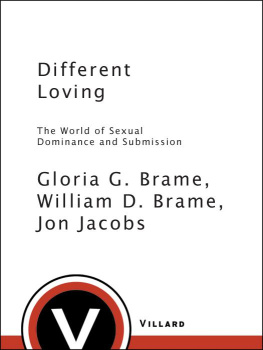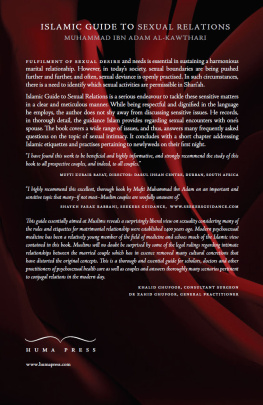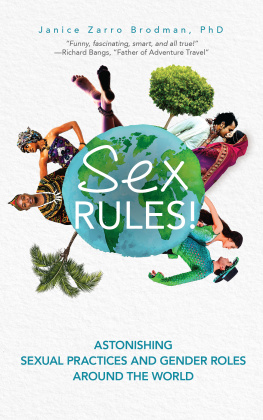
Copyright 1993 by Gloria Glickstein Brame, William D. Brame, and Jon Jacobs
All rights reserved under International and Pan-American Copyright Conventions. Published in the United States by Villard Books, a division of Random House, Inc., New York.
Villard Books is a registered trademark of
Random House, Inc.
Grateful acknowledgment is made to the following for permission to reprint previously published material:
GUY BALDWIN, M.S.: Excerpt from Old Guard: Its Origins, Traditions, Mystique and Rules by Guy Baldwin, published in Drummer 150 . Reprinted by permission of Guy Baldwin, M. S.
HAWORTH PRESS, INC.: Excerpts from The Sexually Unusual: Guide to Understanding and Helping edited by Dennis M. Dailey. Reprinted by permission of Haworth Press, Inc., 10 Alice Street, Binghamton, New York, 13904.
THE JOHNS HOPKINS UNIVERSITY PRESS: Excerpts from Deviation and Variation and The Sadomasochistic Contract from Variant Sexuality: Research and Theory edited by Glenn D. Wilson. Reprinted by permission.
PENGUIN BOOKS USA, INC.: Excerpt from a James Joyce letter dated December 6, 1909, published in Selected Letters of James Joyce by James Joyce, edited by Richard Ellman. Copyright 1957, 1966, renewed 1985 by The Viking Press, Inc. Copyright 1966, 1975 by F. Lionel Munro, as administrator of the estate of James Joyce. Reprinted by permission of Viking Penguin, a division of Penguin Books USA, Inc.
PLAYBOY MAGAZINE: Excerpt from Thats Me On Top, Helpless by Craig Vetter from the June, 1974, issue of Playboy magazine. Reprinted by permission.
LARRY TOWNSEND: Excerpt from The Leathermans Handbook II by Larry Townsend, published by Carlyle Communications, Ltd. Reprinted by permission of Larry Townsend.
Library of Congress Cataloging-in-Publication Data
Brame, Gloria G.
Different loving: the world of sexual dominance and submission / by Gloria G. Brame, William D. Brame, Jon Jacobs.
p. cm.
Includes bibliographical references.
eISBN: 978-0-307-80347-4
1. Sadomasochism. I. Brame, William D. II. Jacobs, Jon. III. Title.
HQ79. B69 1993
306.775dc20 92-37144
v3.1

A CKNOWLEDGMENTS AND D EDICATIONS

We dedicate this book to the precious memory of poet Judson Jerome, whose commitment to candor inspired and first guided us.
We were blessed to have Russell Galen as our mentor, literary agent, critic, and friend. We are grateful to our editor, Peter Gethers, for his vision, commitment, and courage. Also to Sharyn Rosenblum for her loyal support.
We owe special thanks to NP, whose hard work and innumerable contributions to this project only the authors can know; and to Garison Kaufman, whose insights enhanced the quality of the final text. Dr. Robert H. Nightingales medical expertise and friendship were indispensible. Miguel Garcia provided valuable assistance.
This book is the result of a collaboration among three good friends and, since inception, has been enthusiastically supported by the large network of friends who comprise our extended family. We cannot list everyone, but must single out John Gallant, Bruce Bawer, Chris Davenport, Jay Riggs, Helen Jacobs, Bern Poliakoff, and Berl Boykin, all of whom sustained us with their loyalty and love.
Although we cannot thank them individually, scores of helping professionals and activists lent support to this project. We would especially like to thank William Henkin, Howard and Martha Lewis, the late Roger Peo, Fakir Musafar, Robin Young, Thomas Gramstad, and Marie-Constance.

A N OTE ON I NTERVIEWS AND N AMES

Different Loving includes extensive quotes and personal profiles drawn from in-depth interviews with well over 100 participants in and experts on dominance and submission. They were conducted between the spring of 1991 and the spring of 1992. Our interviewees were uniformly open and forthcoming, and, naturally, many of the interviews tended to wander, often far afield of the main theme of this book. We have edited and compacted the interviews so as to allow each person to speak for him- or herself while keeping this book at a readable length.
Each of our interviewees was given the option to appear under his or her true name or under a pseudonym. Most chose, for obvious reasons, to appear under pseudonyms; some, who are already publicly known, appear under their real names; and some others who appear under their real names do so here for the first time in terms of their interests in D&S: They have chosen to use Different Loving as an opportunity to come out.

C ONTENTS


D ISCLAIMER

This book explores highly controversial and risky sexual activities. Readers should not attempt any of the activities described in these pages . Neither the authors of this book, nor its interviewees, nor its publishers assume any responsibility for the exercise or misuse of the practices described herein.
As the statements of our interviewees make clear, D&Sers are exquisitely aware of the hazards inherent in what they do and take care to anticipate them, to understand them, andmost importantto avoid them. The authors provide only basic and incomplete health warnings in the appropriate chapters to remind readers of the serious hazards involved.
D&Sers make a real and absolute distinction between explicitly consensual acts between adult partners for their mutual pleasure and all acts of violence against unconsenting partners. Imposing any sexual activity on a reluctant partner is morally offensive; imposing it on an unwilling partner (or upon anyone who cannot give legal consent) is a criminal offense. Further, state laws vary: Some of these activities, even between consenting partners, are illegal in certain jurisdictions.

SECTION ONE

D IFFERENT L OVING

One

I NTRODUCTION
I n order to understand unusual sexualities such as dominance and submission (D&S), one first has to consider the question, What is normal? If the unique function of sex is reproductiveand the only reason men and women should engage in sex is for the purpose of creating new lifethen only heterosexual intercourse is normal. Masturbation, oral sex, and even contraception must be considered aberrant. Reproductive relevance was the Victorian standard of normalcy, and even today many of the laws defining criminal sexual behaviors in the United States still abide by that model. In reality, however, people have always pursued sex for reproduction as well as for pleasure and well-being.
Next page










